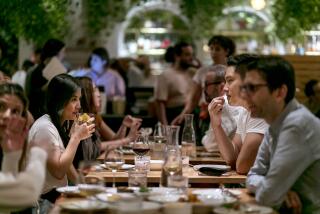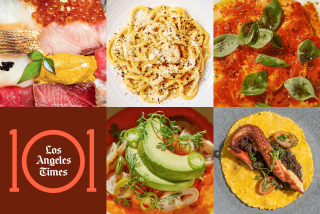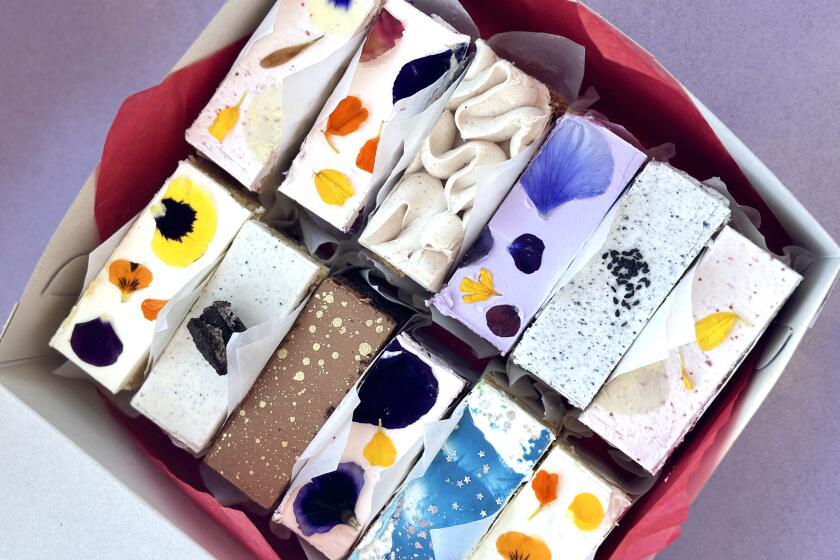SEOUL FOOD : L.A. Korean Pubs Provide Authentic Snacks, Culture
Wish you were at the Olympics? Think of the traffic, the trouble getting a hotel room, the endless waits at airports. And be grateful that you can get an authentic taste of Korean culture without ever leaving home.
S ulchip --casual pubs frequented by students and working-class Koreans--are virtual institutions of Korean life; every neighborhood has at least one. And they are showing up in Los Angeles too.
In Korea, sulchip range from tiny nondescript holes-in-the-wall to more elegant gathering places. Monee Jeo on Beverly Boulevard ranks with the classier ones. Instead of catering to scruffy students or a rough-and-tumble crowd, this pub is a haven for Korean yuppies. The house specialty is tongdongju , a refined version of makkolli , which is a mellow, sake-like brew with a centuries-old history. Most people instantly love its mild flavor.
But no Korean drinks makkolli without eating plenty of anju --hearty pub snacks. And because anju dishes aren’t spicy--except for the accompanying kimchis-- non-Koreans have no trouble downing plate after plate.
Though Koreans don’t consider anju “dinner,” they often linger long enough at the sulchip to make a meal of them. At Monee Jeo, groups spend hours snacking, drinking and engaging in spirited conversations. Such meals have much the same appeal as Spanish tapas or Japanese kappo : You can eat a little and then decide what you feel like next.
Every detail of Monee Jeo has been crafted to remind Koreans of the old-fashioned student pubs back home: thick wooden ceiling beams, coarse plaster walls, replicas of antique pottery and room dividers made of wood-slat doors and oiled paper. And like American pubs, there’s music. But instead of the strains of a long-hair folk guitarist, there’s Lee Keun Chan, who entertains guests with a collection of classical instruments arranged on a mini stage in the restaurant’s foyer. Sometimes he plucks out soft, beautiful melodies on a 12-string zither-like kayagum, other times he beats rhythms on the chang’gu drum while playing the reedy oboe-sounding p’iri. During his breaks, there are the sounds of haunting half-sung, half-chanted Korean folk songs on tape, which tell both oral history and popular folklore. Neither the tapes nor the live music are ever loud enough to interrupt conversation. And despite the eminence of Keun Chan--he earned the Korean government’s Human National Treasure designation--an evening at Monee Jeo is far from stuffy.
You sit on beautiful silk pillows, and waitresses in old-fashioned country dresses bring menus calligraphed on bamboo scrolls. The first order of business should be the ordering of tongdongju. (I like the plain tongdongju best, although some prefer susam tongdongju ( tongdongju with ginseng), which doesn’t appear on the English menu but is always available.) The cool, milky-white liquid is delivered to the table in a large, pale-blue stoneware bowl. Portions are ceremoniously dipped out into cups with half of a dry gourd used as a ladle.
On my first visit, I brought a Korean friend who knew exactly what to order without giving the menu a glance. “You must always have kulbossam and pindaettok with your tongdongju ,” she said knowingly. She was right, each taste married perfectly with the drink. Pindnaettok, already familiar to most Korean food lovers, are crispy potato pancake-like rounds made of bean flour with crunchy vegetable pieces in the batter. Our waitress cut the pancakes into squares and offered a dip of soy sauce and toasted sesame seeds. A spicy variation, kochu pindaettok, includes fresh hot green peppers in the pancake.
Kulbossam , sort of an oyster taco, had its components brought out on several plates. We assembled our own by piling a few baby oysters, a bit of finely shredded radish-kimchi and fresh pine nuts onto a piece of salted cabbage, and then rolling the whole thing up. Kulbossam is another item that is not on the English menu; ask for it anyway.
The English menu does have plenty of appealing choices, however. Modumjon (badly described as “fried dough” with beef, fish and vegetables) is an assortment of delicacies prepared in a tempura-style batter: sesame leaves stuffed with ground beef, like a little sandwich; stuffed baby green peppers; tiny oysters; and various fish and vegetables. P’ajon, another item termed “fried dough,” turns out to be a luxurious, eggy oyster-and-scallion pancake.
On our next visit, we started with p’yonyuk, a Korean version of boiled brisket. The barely seasoned meat slices are absolutely perfect with the accompanying shredded scallion salad and a collection of side dishes known as panch’an. At Monee Jeo the panch’an change almost daily. One night you’ll find oiji (pickled cucumbers with hot pepper) and miyok much’im (a small salad of carrot and seaweed); other nights, entirely different dishes.
Besides these, there are always the Korean standbys--an incendiary cabbage kimchi and a mild refreshing water kimchi. And even though anju are not a formal meal, everyone is served little covered bowls of rice. Beer, tea and soft drinks are also available.
Monee Jeo, 3121 Beverly Blvd. (east of Vermont) , (213) 382-3271. Open daily, 4 p.m.-2 a.m.. Tongdongju, $8.99 (serves 4), pindaettok, $6.50, mondumjon, $9.75, p’yonyuk, $9.95, kulbossam, $11.75.
More to Read
Eat your way across L.A.
Get our weekly Tasting Notes newsletter for reviews, news and more.
You may occasionally receive promotional content from the Los Angeles Times.






